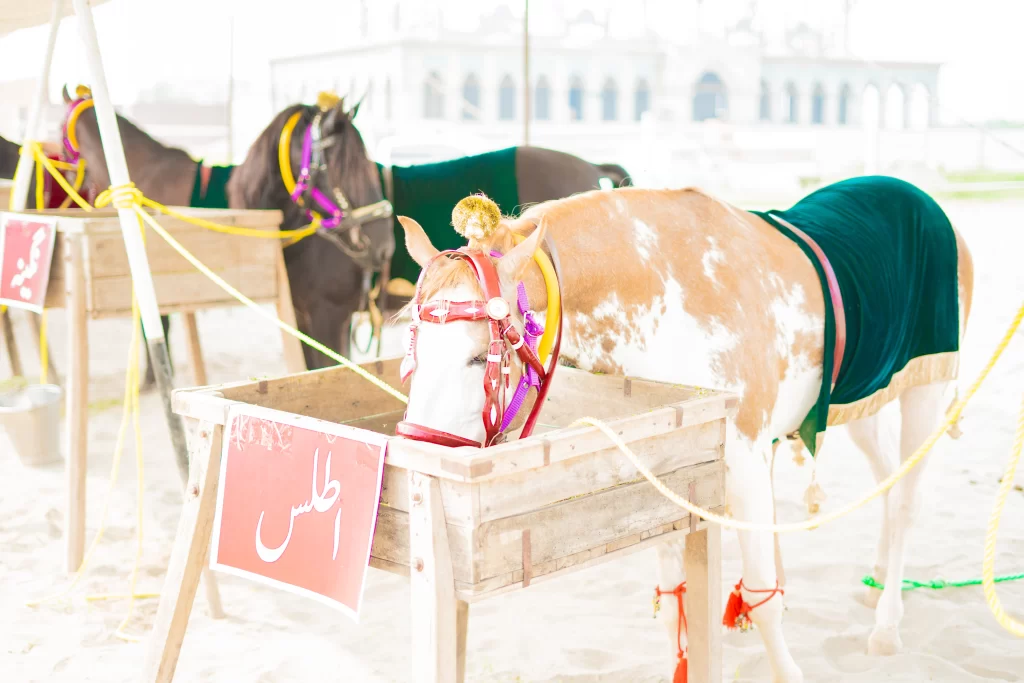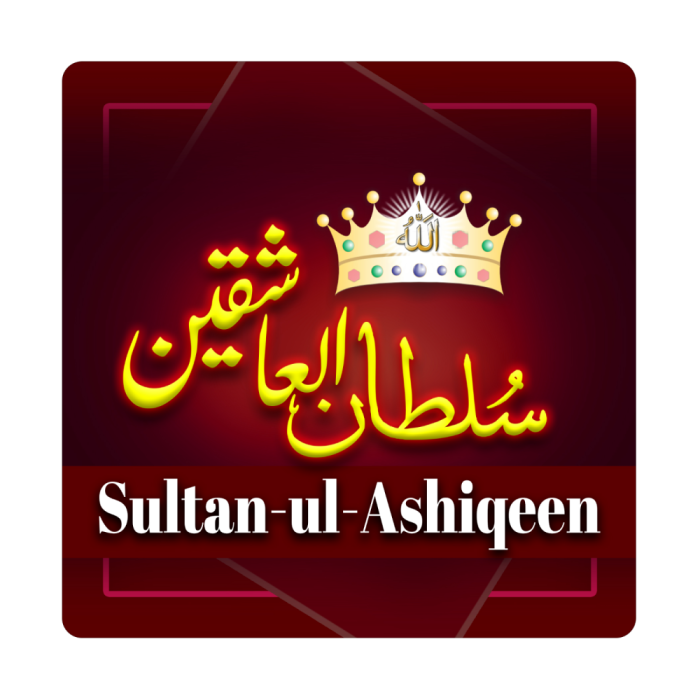Sultan-ul-Ashiqeen’s Love and Devotion for the Horses
Raising horses for Allah’s pleasure and approval is a practice deeply honoured by prophets and a cherished tradition upheld by Saints and perfect Fakirs. Numerous Hadiths offer profound insights into the significance of cherishing these noble creatures.
On 26 December 2003, Sultan-ul-Ashiqeen Sultan Mohammad Najib-ur-Rehman ascended to the spiritual throne of Divine guidance and persuasion of the Sarwari Qadri order, after the death of his spiritual guide, Sultan-ul-Faqr VI Sultan Mohammad Asghar Ali. This period he marked an era of rapid development and groundbreaking innovations. The pervasive influence of social media was rapidly spreading, leading many to turn towards worldly pursuits. Furthermore, the prevalence of counterfeit and imperfect spiritual guides has caused people to stray from the authentic path of Sufism.
Amid such challenging circumstances, it became imperative to dispel doubts and suspicions through spiritual teachings, guiding individuals toward the true essence of their faith, which is Faqr. Throughout this period, Sultan-ul-Ashiqeen remained deeply immersed in his literary endeavors which focused on Sufism. Simultaneously, he took on the responsibility of overseeing the publication of the monthly magazine “Sultan-ul-Faqr.” Additionally, he continued his extensive series of preaching tours, reaching out to various regions and villages to disseminate the blessings of Ism-e-Allah Zaat (the Personal Name of Allah). Through these efforts, he touched the lives of millions, showering them with the profound beneficence of Faqr.
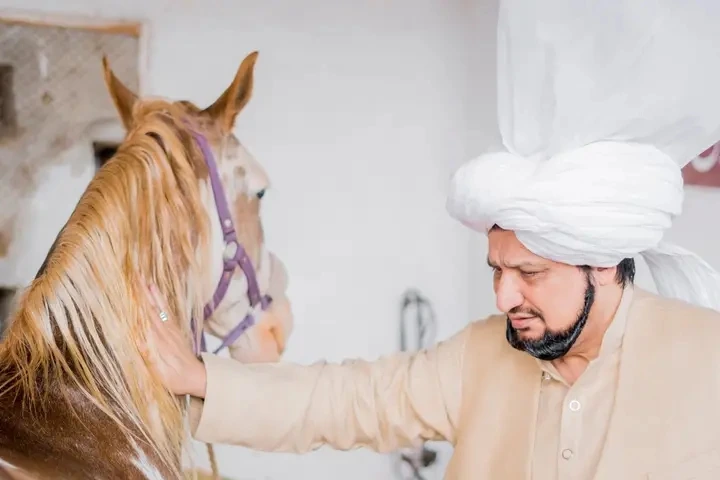
Why Sultan-ul-Ashiqeen Wanted to Keep Horses?
After completing his literary work, Sultan-ul-Ashiqeen received the command to establish the center of Faqr from the Mohammadan Assembly. Thus, he laid the foundation of the Khanqah Sultan-ul-Ashiqeen and Zahra Mosque in Rangil Pur Sharif, Sundar Adda, Multan Road, Lahore. As the construction of these sacred institutions neared completion, Sultan-ul-Ashiqeen, in line with the Sunnah of Prophet Mohammad, decided to maintain a stable of horses. To fulfill this noble purpose, he directed the creation of a stable near Khanqah Sultan-ul-Ashiqeen. Sultan-ul-Ashiqeen named his very first horse "Atlas." He chose this name with utmost reverence and in memory of his beloved spiritual guide, Sultan-ul-Faqr VI, who also had a favorite horse named Atlas. Sultan-ul-Faqr VI had a deep affection for horses and meticulously cared for them. As a result, Sultan-ul-Ashiqeen possesses comprehensive knowledge regarding horse care, issues, and diseases. He consistently provides timely guidance to the stable caretakers. Each year, during the grand gatherings of Mawlid an-Nabi, the head of the stable beautifully adorns horses and displays them in front of the event venue. After the event concludes, seekers of Allah find joy in visiting these majestic creatures. We can understand the significance and virtue of horse-keeping in the light of various Quranic verses and numerous Hadiths.
The Honour of Horses in the Light of Quran
The horse is the only animal that Allah Almighty has sworn by in the Holy Quran. Allah says in Quran:
وَ الْعٰدِیٰتِ ضَبْحًاO فَالْمُوْرِیٰتِ قَدْحًا۔
Meaning: By the charging horses that gallop (in the battlefield) and pant. And those that produce sparks striking their hoofs on rocks. (100:1-2)
It is well known in Arabic culture that Prophet Isma’il was the first person to ride a horse. There is a narration regarding Prophet Dawud that he had a special passion for horses. He had a thousand horses, which he passed on as an inheritance to Prophet Solomon. He used to say, “The dearest wealth I have inherited from my father is these horses.”
An incident of Prophet Solomon’s love for horses is mentioned in the Holy Quran in the following words:
Meaning: And We blessed David) with (a son) Solomon. What an excellent servant he was! Indeed, he constantly turned to Allah. Remember when the well-trained, swift horses were paraded before him in the evening. He then proclaimed, ‘I am truly in love with these fine things out of remembrance for Allah. They (horses) ran (so fast) until they went out of sight. He ordered, ‘Bring them back to me! Then he began to rub down their back and neck out of love. (38:30-33)
Magnificence of Horses in Light of Hadiths
The following narrations of the Hadiths mention the blessings associated with the horses:
- Abdullah ibn Umar narrates that the Messenger of Allah said, “(Allah) has placed goodness in the foreheads of horses until the Day of Judgment.” (Musnad Ahmad ibn Hanbal 5200)
- Jarir ibn Abdullah narrated: “I saw the Messenger of Allah (peace be upon him) twisting the forelock of a horse with his fingers and he was saying, ‘Until the Day of Judgement (Allah has attached) goodness and reward to the forelocks of horses.’” (Muslim 4847)
- Jabir ibn Abdullah narrated, “The Messenger of Allah said, ‘Until the Day of Judgment, (Allah has attached) goodness and the desired goals to the forelocks of horses. Their owners ride them and deal with difficulties, so touch the forelocks of horses, supplicate for blessings upon them, and put bridles upon them, but do not treat them with cruelty.'” (Musnad Ahmad ibn Hanbal 14851)
- Jarir bin Abdullah reported, “The Messenger of Allah (peace be upon him) moved the hair from the forelock of a horse with his fingers and said, ‘(Allah has attached) goodness in the form of reward and booty to the forelocks of horses until the Day of Judgment.’” (Musnad Ahmad ibn Hanbal19410)
The Virtue of Serving and Honouring Horses
Arabs’ nobles and tribal chiefs used to personally serve and honour horses. They did not delegate these tasks to servants or slaves. The wise among the Arabs used to say that there is no shame in performing three tasks for the tribal chiefs and nobles: serve father, guest and a horse.
The Prophet Mohammad (peace be upon him) also emphasized the great virtue of serving and honouring horses.
- Abu Huraira narrated, the Prophet said, “Whoever believes in Allah and His promise, and then tends to (care for) a horse belonging to His Cause (i.e., Jihad), (Allah) will reward him on the Day of Judgment for the horse’s sustenance (feeding and drinking) and the horse’s droppings and urine.” (Musnad Ahmad ibn Hanbal 8853)
- Abu Huraira reported: The Prophet Mohammad said, “If somebody keeps a horse in Allah’s cause motivated by his faith in Allah and his belief in His Promise, then (Allah) will reward him on the Day of Resurrection for what he fed the horse. Also, for (picking up) its dung and urine.” (Bukhari 2853)
Nobles in History Personally Took Care of Horses
- Ruh bin Zinbaa narrated: I went to visit Tameem Ad-Dari and saw that he was cleaning the barley for his horse while he was surrounded by his family members. I asked, “Is there anyone among your family who can do this work instead of you?” He said, “Why should I not do it? I heard the Messenger of Allah (peace be upon him) saying: ‘Whoever cleans barley for his horse and then feeds him, Allah will forgive him on account of every straw of its feed and every sip of its drink and will cause him to enter Paradise.'” (Musnad Ahmad-ibn-Hanbal 5197)
- Abu Huraira narrated that when someone asked the Prophet (peace be upon him) about horses, he said, “The foreheads of horses are associated with goodness until the Day of Judgment. A horse is a source of reward for some, a veil for others, and a source of sin for yet others. The horse becomes a source of reward for the one who raises it for the sake of Allah, such a horse is the one that when it consumes something, in its consumption, there is reward for its owner. Even when it walks for a few steps, there is a reward for its owner with every step it takes. If it comes to a river and drinks water, for every drop it drinks, there is a reward for its owner.” The Prophet even mentioned the reward for its dung and urine. (Musnad Ahmad-ibn-Hanbal 8965)
Reward on Taking Care of Horse for Sake of Allah
- Abu al-Darda and Sahl ibn Hanzala reported that the Messenger of Allah said, “The one who spends on a horse for the sake of Allah is like a person who extends his hands for charity and does not hold back.” (Musnad Ahmad-ibn-Hanbal 5198, 17768)
- Asma bint Yazid narrated that the Messenger of Allah (peace be upon him) said, “(Allah) associated goodness with the forehead of the horses until the Day of Judgment. This means they will always be a source of virtue. So, the person who keeps a horse for the sake of Allah, spends on it with the intention of earning reward from Allah, then eating, thirst, riding and even droppings and urine of such horse will be the cause of his success on the Day of Judgment. But the one who raises a horse for the sake of show, fame, or pride, then the horse’s eating, being thirsty, going on journeys, and even its urine and dung, all of these things will lead to his loss on the Day of Judgment.” (Musnad Ahmad-ibn-Hanbal 28126)
Sultan-ul-Ashiqeen Loves Horses for Sake of Allah
Due to the abundance of Hadiths emphasizing the service and honour of horses, Sultan-ul-Ashiqeen holds a deep reverence to these noble creatures. Likewise, he cherishes the seekers of Allah appointed to look after horses for the same reason. Whenever he enters the stable, Sultan-ul-Ashiqeen takes keen interest in the well-being of the horses. He inquires about their needs, asks about their meal schedules, and meticulously addresses any other concerns that may arise.
Furthermore, he frequently imparts valuable guidance to his disciples, emphasizing that these horses are maintained solely for the pleasure of Allah, not out of personal desire. Therefore, it is their duty to serve these animals wholeheartedly for the sake of Allah, ensuring their comfort and sustenance while diligently avoiding any form of negligence.
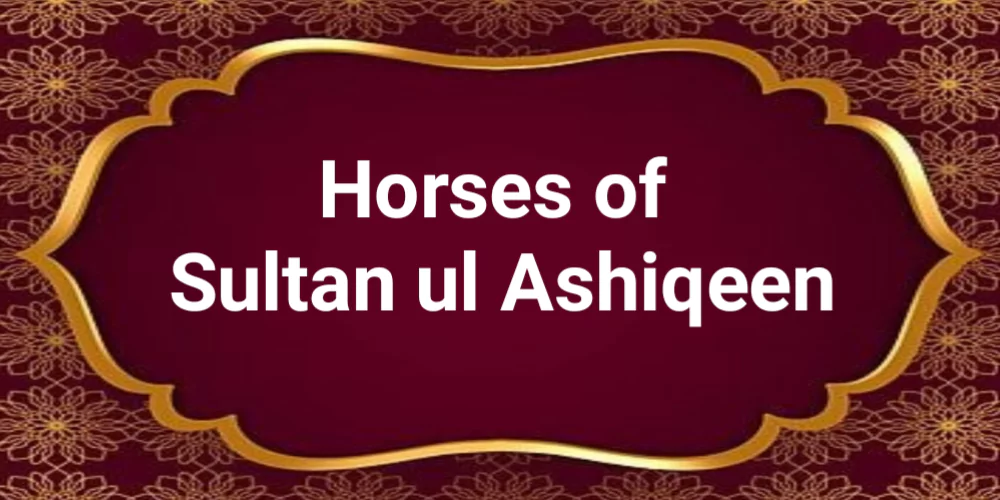
The Virtue of Horse Racing
Every action of Sultan-ul-Ashiqeen reflects that he is on the footsteps of Prophet Mohammad. Following the Sunna of the Holy Prophet and his beloved spiritual guide, Sultan-ul-Ashiqeen loves to watch the horse race. For this purpose, Sultan-ul-Ashiqeen designated a special place behind Khanqah Sultan-ul-Ashiqeen where horse racing is conducted.
Conducting Horse Race is Sunna of the Prophet
Below are some Hadiths related to horse racing:
- Imam Ahmad ibn Hanbal, narrating from Nafi’, who narrates from Abdullah ibn Umar that the Prophet of Allah organized a horse race, and he set a distant point for the horses to reach the fifth year. (Abu Dawood 2577)
- Abu Ishaq narrates that Abdullah ibn Umar said, “The Prophet held a horse race for those horses which had been trained. The race started from al-Hafya and ended at Thaniyat al-Wada.” (Abu Ishaq) asked Abu Musa, ‘What is the distance between the two places?’ He replied, “About six or seven miles.” The Prophet also conducted a horse race for those horses which had not been trained. This race began from Thaniyat al-Wada and ended at the Mosque of Bani Zuraiq. Abu Ishaq asked about the distance, and he replied, “Approximately one mile.” Abdullah ibn Umar also participated in these races. (Bukhari 2870)
- Imam Malik, narrating from Nafi’, who narrates from Abdullah ibn Umar, reported that the Prophet of Allah organized a horse race for those horses which had been made swift and agile by reducing their fat. The race started from al-Hafya and ended at Thaniyat al-Wada’. The horses which had not been made agile raced from Thaniyat al-Wada’ to the Mosque of Bani Zuraiq. Abdullah ibn Umar was among those who took part in racing the horses. (Muslim 4843)
Horses of Prophet Mohammad
As previously mentioned, the Prophet had a profound affection for horses. He possessed a number of horses, each with its own unique characteristics. Here is the list of the horses owned by Prophet Mohammad:
1- Al-Sakb (The Swift):
This horse had a reddish-black coat with a white forehead and a white marking on its left hoof. Ibn Taseer mentioned that it was primarily black in colour. It was the very first horse of Prophet Mohammad that he purchased from a Bedouin for ten ounces of silver. The Prophet rode this horse in the Battle of Uhud. In that battle, Muslims had no horse other than the horse of Abu Baradah and al-Sakb.
2- Al-Murtajaz (The Reciter):
This horse earned its name due to its beautiful neighing. It had a striking black and white coat. Some scholars suggest that it was an original breed.
3- Al-Lahf (The Galloper):
It was named because of its long tail, as if it was spread on the ground. This horse was given to the Prophet as a gift by Rubai’ah bint Abi Al-Bara’ or Firdah bin ‘Amr Al-Juzami.
4- Al-Lazaz (The Fast Runner):
This horse earned its name due to its incredible speed. As it used to run so swiftly that it would rapidly reach its destination. Maqwaqas gifted this horse to the Prophet.
5- Al-Zarib (The Small Mountain):
It was a robust and sturdy horse. It was given to the Prophet by Firdah bin ‘Amr.
6- Al-Ward (The Rose):
Tameem Dari presented this horse to the Prophet. Later, the Prophet gave this horse to Umar ibn Khattab. The horse was named after its reddish yellow colour.
7- Sabhah (The Swimmer):
This horse was named because of its exceptional speed and graceful gait.
Hafiz Sharif al-Din al-Dimyati stated that there is a consensus regarding these seven horses, and the Prophet mostly rode Al-Sakb.
Following the traditions of the Prophet, Sultan-ul-Ashiqeen has also named his horses. The names of his horses are Shahbaz, Kabootra, Chan, Sher Dil, Nageena, and Atlas. These names are inspired by the names of the horses owned by his spiritual guide, Sultan-ul-Faqr VI Sultan Mohammad Asghar Ali.
Reason for Keeping Horses
Many people, due to their lack of understanding, often associate horse keeping with materialism and leisure, but the reality is quite the opposite. Below, some Hadiths of the Prophet are mentioned to shed light on the virtues of horse keeping so that those with limited knowledge can gain a better understanding.
- Abu Huraira narrated that the Messenger of Allah said, “The forelock of a horse is tied to goodness till the Day of Judgement. The horse is for three (purposes): First is a source of reward for a man. A source of shelter (from poverty) for a man and it is a source of sin for a man. It is a source of reward for the one who acquires it for the cause of Allah and then prepares it for that cause. As Allah rewards its owner in return for the sustenance that such horse feeds on. (Tirmidhi 1636)
Verification of this Hadith in Musnad Ahmad
- Abdullah bin Mas’ud reported that the Prophet once said, “Horses are of three kinds. The first one is for the sake of the Most Merciful (Allah), the second is for man and the third is for Satan. The first kind is a horse kept for the sake of Allah and there is a great reward for its owner. Even its food, droppings, urine (and other aspects of its care) are a source of reward for the owner. (Second category is) the Satanic horse is used for gambling (which was common during the days of ignorance). The third category is the horse kept to fulfil one’s desires, such as breeding it to have offspring which can then aid in various household needs and shelter him (from poverty). (Musnad Ahmad ibn Hanbal 3756)
All the horses owned by Sultan-ul-Ashiqeen are of exquisite breeds and are solely kept for the purpose of pleasing Allah and His Prophet. They are not kept out of mere interest or materialistic reasons.

Allah Granted Permission to Horses Supplicate.
- Mu’awiya ibn Hudayj narrated from Abu Dharr, who reported that the Holy Prophet said, ‘(Allah) has given permission to every Arab horse to make two supplications at the time of dawn salat.’ It supplicates, ‘O Allah! Among the children of Adam, wherever You placed me, make me more beloved to him than his family, wealth, and children.’ (Musnad Ahmad ibn Hanbal 21829)
- Abu Shamsah reported that Mu’awiya ibn Hudayj passed by Abu Dharr while he was attending to his horse. He asked him, ‘You are always engaged with your horse.’ Abu Dharr replied, ‘I believe (Allah) answered the supplication of this horse.’ Ma’awiya inquired, ‘What is the reality of the supplication of a hoofed animal?’ Abu Dharr said, ‘I swear by Him in whose hand is my soul, there is no horse who does not supplicate in the morning saying, ‘O Allah, You have placed me under the care of one of your servants and entrusted my sustenance to his hands. Make me more beloved to him than his family, wealth and children.’ (Musnad Ahmad ibn Hanbal 21773)
Condemning the humiliation of Horses
The Prophet Muhammad strongly discouraged the humiliation and mistreatment of horses. He prohibited actions such as cutting their tails, castrating them and cutting the hair on their foreheads. This is because horses are prideful animals and such actions go against their natural disposition, causing them distress.
- Atbah ibn Abdul Salam narrated that the Messenger of Allah prohibited cutting the hair on the neck, tail, and forehead of a horse. He explained, “The tail of a horse keeps away flies and other pests, the hair on its neck provides warmth, and as for the forelock, Allah has connected goodness to it until the Day of Judgment.” (Musnad Ahmad ibn Hanbal 17790)
Horses are sensitive creatures capable of sensing human behaviours and following instructions. They not only recognize their owners but also learn to behave well when taught. Sultan-ul-Ashiqeen strictly prohibited castrating horses and cutting their hair. He issued special instructions to the caretakers of horses, emphasizing that no action or behaviour should be adopted that can cause distress to these noble animals.
Beloved Horses of the Holy Prophet
- Abu Qatadah narrates from the Prophet, “The best horse is one that is black with a white mark on its forehead, a white upper lip or nose, has three white legs and the right foreleg is the same colour as the horse’s body. If it is not black, then a horse that is red with intense blackness and its ears are black is also like it.” (Tirmidhi 1696)
- Abdullah bin Abbas narrated that the Prophet said, “There is a blessing in the red-coloured horse.” (Abu Dawood 2545)
Sultan-ul-Ashiqeen possesses a variety of horses, including black, reddish-black, white and red. All these horses are exceptionally beautiful, attractive and vigorous.
Horses of the Perfect Saints

Shaikh Abdul Qadir Jilani had several horses in his stable. Scholars narrate that even the horseshoes were made of gold. Shaikh Abdul Qadir Abarli writes in Tafrih al-Khatir fi manaqib:
- A person in Baghdad saw the stables of Shaikh Abdul Qadir Jilani. The stable had forty horses of the finest breed, tied with the nails made of gold and silver and their backs adorned with silk covers” (Manaqib 55)
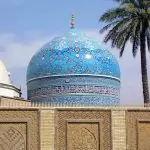
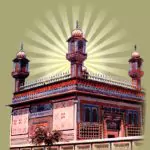
Sultan Bahoo was also fond of horses. According to some narrations, Prophet Mohammad gifted him a pair of horses and their lineage continues even today. (The Spiritual Guides of Sarwari Qadri order)


Sultan Mohammad Asghar Ali, the spiritual guide of Sultan-ul-Ashiqeen also had a large number of horses. He himself was an excellent equestrian and a skilled falconer. Every year, he organized falconry competitions in the Uchhali Valley. The primary purpose of these competitions was to spread Faqr (Sufism) so that those who did not participate in religious gatherings could benefit from the company of Sultan-ul-Faqr VI. These events aimed to transform worldly seekers into seekers of Allah.

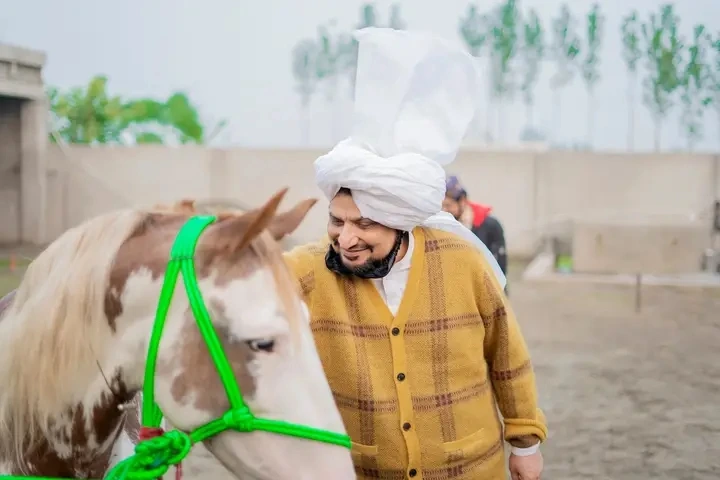
Sultan-ul-Ashiqeen immersed himself so deeply in the love of his spiritual guide that his actions became a true reflection of it. Embracing every action and tradition of his spiritual guide is an expression of Sultan al-Ashiqeen’s love for his spiritual guide. Sultan Mohammad Asghar Ali also had immense love for horse and so does Sultan-ul-Ashiqeen.
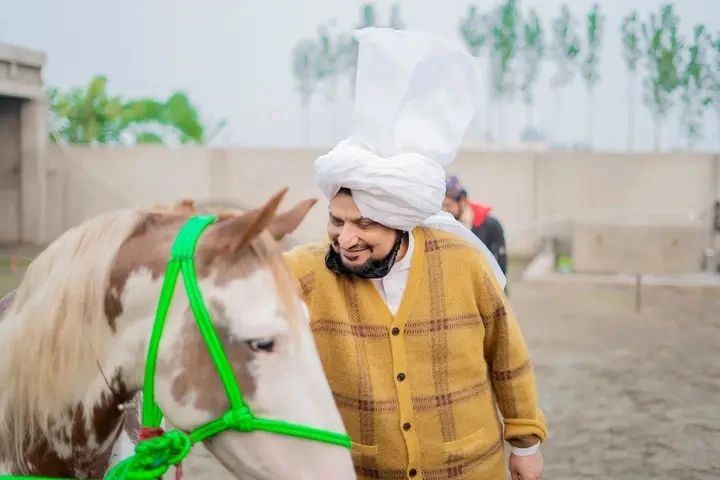
Sultan-ul-Ashiqeen’s Affection for Horses
Sultan-ul-Ashiqeen’s arrangement is such that whenever he visits the Khanqah Sultan-ul-Ashiqeen, his first priority is to inspect the stable. He displays genuine fondness for the horses, meticulously inquiries about their dietary needs and medical requirements and underscores the significance of their overall well-being. His involvement goes beyond mere inquiry; he personally conducts research on their health and ailments and extends this responsibility to his devoted disciples. Should any of the horses fall ill, it greatly perturbs him, prompting immediate calls to summon a veterinarian. On numerous occasions, he suggests herbal remedies for their recovery. Sultan-ul-Ashiqeen maintains a vigilant watch over the condition of the horse until it is restored to full health. He has placed a First Aid box within the stable, emphasizing its importance for prompt medical assistance in emergencies.
To ensure thorough monitoring of the horse’s daily activities, the heads of stable established a Signal app group under the supervision of Sultan-ul-Ashiqeen. Through this digital platform, Sultan-ul-Ashiqeen remains apprised of all matters concerning the horses and promptly issues directives as necessary.
Sultan-ul-Ashiqeen has entrusted Sahibzada Sultan Muhammad Murtaza Najib with the special responsibility of caring for the horses, guaranteeing their unwavering attention and care. Furthermore, Professor Sultan Hafiz Hammad-ul-Rahman, one of Sultan-ul-Ashiqeen’s successors, also assumes a vital role in overseeing the horses.
Horses of Sultan-ul-Ashiqeen
In local horse breeds, a set of sixteen attributes hold profound significance, with each contributing to the horse’s overall quality and value. These attributes can be categorized into four distinct groups, each defining a specific aspect of the horse’s physique and form:
- Thick Attributes: This group encompasses the eye, nose, joint, and thigh – attributes that underscore the horse’s robust and powerful build.
- Small Attributes: This category includes the pastern (the area between the knee and fetlock), ear (where the reins are held), thigh and joint. These features contribute to the horse’s grace and poise.
- Round Attributes: Rounded features, such as the fetlock, chest, waist, and forehead, signify vitality and harmonious proportions, adding to the horse’s aesthetic appeal.
- Long Attributes: The cannon (the distance between the ankle and knee), neck, gullet (from the knee to the fetlock), and tail fall into this category. These elongated traits are indicative of the horse’s endurance, elegance, and balance.
Remarkably, Sultan-ul-Ashiqeen’s horses embody all sixteen attributes, making them exemplars of equine excellence. The names of his horses are Shahbaz, Kabootra, Chan, Sher Dil, Nageena, and Atlas. Below we have given is a brief description of all the horses. While describing each horse, we refrain from redundant enumeration of the aforementioned attributes, focusing instead on those that immediately capture the observer’s attention.
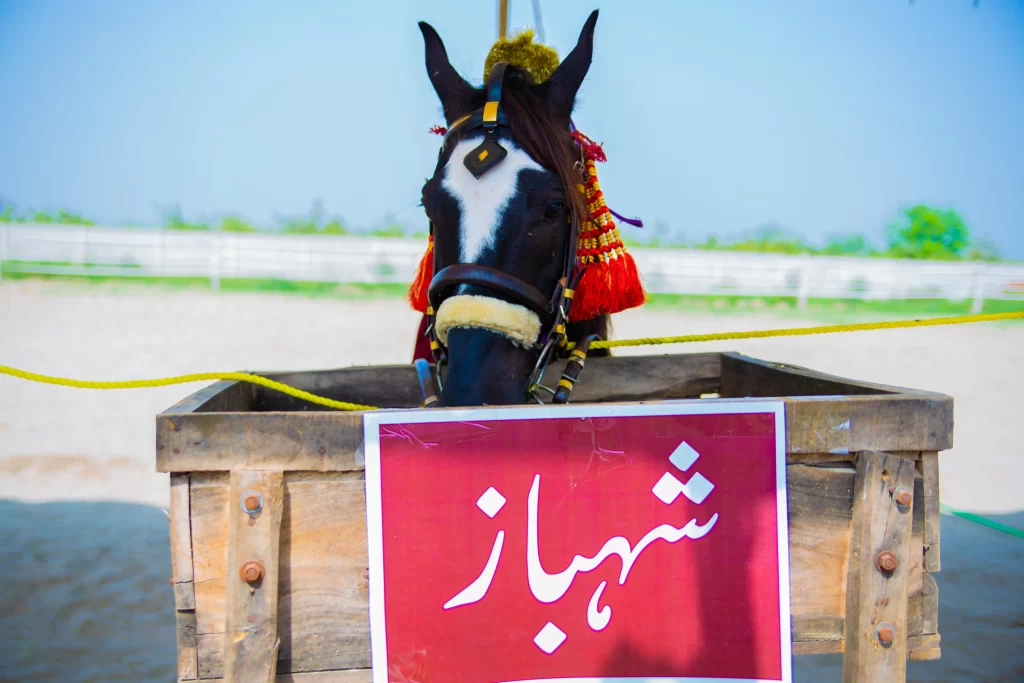
Shahbaz
Ibn Qayyim writes in his book, Zad al-Ma’ad:
“The worth and value of a ride (horse) are determined by its rider.”
Among Sultan-ul-Ashiqeen’s horses, Shahbaz proudly exemplifies this sentiment as he had the privilege of being ridden by him. This horse is the epitome of magnificence and beauty. It boasts a lustrous black coat adorned with a striking white mark on its forehead. This characteristic is often referred to as a ‘blaze’. Shahbaz, in all its splendor, possesses a remarkable intelligence. It swiftly comprehends any instruction imparted to it, and once a particular action is forbidden, it refrains from repeating it. Its resounding neigh carries an aura of awe, often igniting a symphony of responses from Sultan ul-Ashiqeen’s other steeds, as though Shahbaz’s voice uplifts their spirits.
Features of Shahbaz
Shahbaz’s ears are a marvel to behold – pointed and gracefully poised. When they angle forward, their upper edges almost converge, creating a minuscule gap discernible only upon close inspection. In this posture, Shahbaz exudes an even greater aura of grandeur. Its neck, relative in length to the average horse, enhances its overall grace. Remarkably, when Sultan-ul-Ashiqeen lays his blessed hand upon Shahbaz’s forehead, the horse instinctively draws nearer which is a silent expression of its affection towards him.
Both hind legs of Shahbaz bear the hue of pristine white, and its large, expressive eyes are a hallmark of equine beauty. Its towering stature is a testament to its swiftness and agility, for in the world of horses, height often signifies speed and prowess. Shahbaz, indeed, stands tall, embodying the essence of a swift and fleet-footed steed.
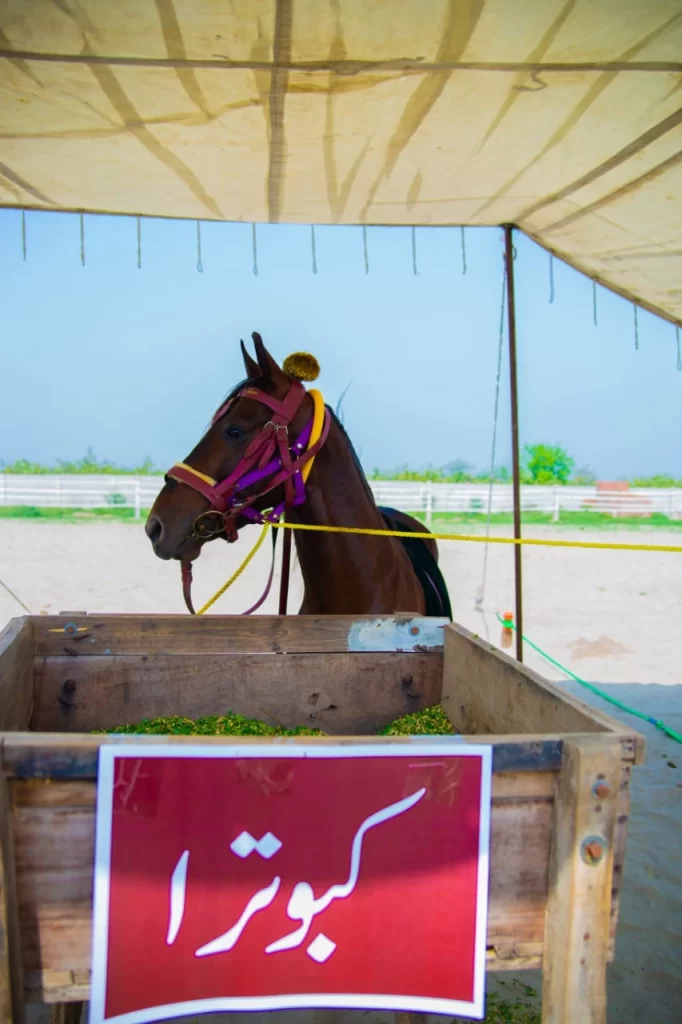
Kabootra:
This horse is an embodiment of equine nobility, boasts a distinctive and captivating appearance. Its coat is a mesmerizing shade of reddish-black, akin to the richness of musk. This unique hue has earned it the endearing nickname “Teelia Mashka,” drawing parallels to the colour of precious oils. Kabootra has beautiful jet-black mane, a hallmark reminiscent of the distinguished Arabian horse lineage. All four of Kabootra’s hooves are shrouded in the same deep black shade, lending an air of majestic elegance to its stature.
One cannot help but marvel at the breadth of Kabootra’s chest, a telltale sign of a horse of exceptional beauty and magnificence. However, this horse’s distinction doesn’t stop at its physical attributes alone. It possesses a remarkable quality that sets it apart – an unwavering commitment to cleanliness. This discerning horse refuses to occupy soiled spaces and steadfastly avoids standing in areas tainted by dirt, reflecting its innate sense of dignity and refinement.
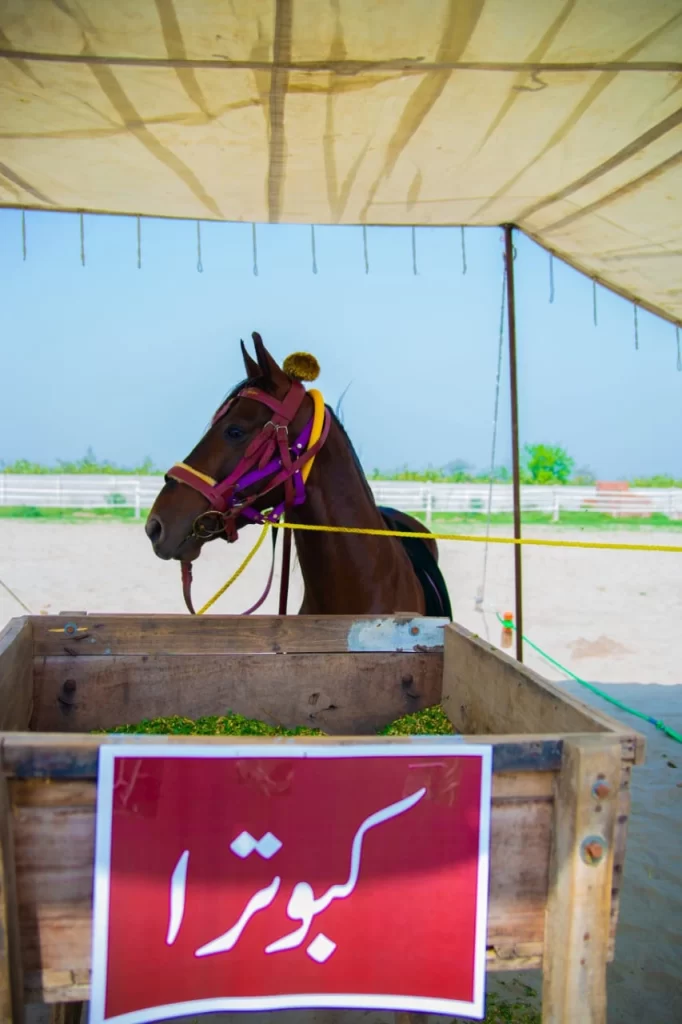

Chan:
Chan is a splendid white horse, which is often colloquially referred to as an albino due to its pristine, snow-white appearance. Its lineage is marked by purity, as its mother was entirely white, and its father was a black horse adorned with four striking white stockings and a bold blaze.
This majestic equine companion boasts a gracefully slender tail, a characteristic often associated with horses of exceptional beauty. Notably, Chan’s chest is impressively broad, an exclusive trait that sets it apart as an exquisite specimen among horses. Its hooves bear an open and robust stance, indicative of its underlying strength.
A distinguishing feature of Chan is the delicate pinkish hue around its eyes and nose, a testament to its pure albino lineage. Connoisseurs of equine beauty often admire its ears, appreciating their shorter distance from each other compared to those of other horses, lending Chan an added touch of elegance.
In horse classification, Chan qualifies as a silver albino, denoting a pristine white coat without any other colour markings. Furthermore, it belongs to the Lipizzaner breed, known for its impressive dancing abilities, with Chan performing the captivating riyodh dance.
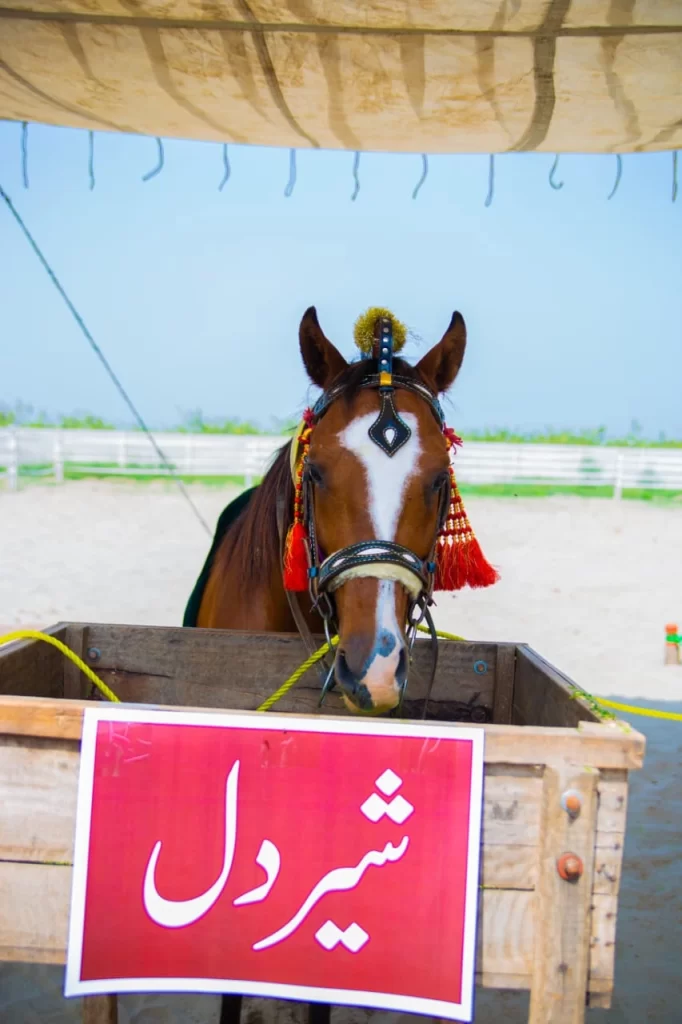
Sher Dil:
The bay-coloured horse holds a special preference among tent pegging enthusiasts. Sher Dil falls into this category. It is a courageous and brave horse. Its lineage traces back to the Kabul horses, which are also found in Mianwali. Kabul has been long recognized as a breeding ground for some of the world’s most dauntless and gallant horses. Sher Dil’s lineage proudly carries forward this legacy of bravery. It’s often said, “No hoof, no horse,” which emphasizes the importance of robust hooves in assessing a horse’s quality. A glance at Sher Dil’s hooves reveals their strength and well-shaped structure. These are the vital attributes for a horse that needs to be swift and agile during tent pegging competitions.
Sher Dil’s swiftness is nothing short of remarkable, often proving challenging for even the most seasoned riders to control. The place from where Sher Dil was purchased is renowned for producing horses with exceptionally sturdy hooves. It has large nostrils which are a valuable asset for a tent pegging horse as it ensures that it doesn’t tire easily during demanding competitions.
Beyond functionality, Sher Dil’s aesthetics also shine through. It has a long face and broad forehead which are very likeable features in the world of equine beauty. Whenever Sultan-ul-Ashiqeen visits stable, Sher Dil keenly takes notice. It repeatedly turns its gaze towards him, lifting its right hoof and rhythmically tapping the ground as if conveying a message that it has recognized Sultan-ul-Ashiqeen’s presence.
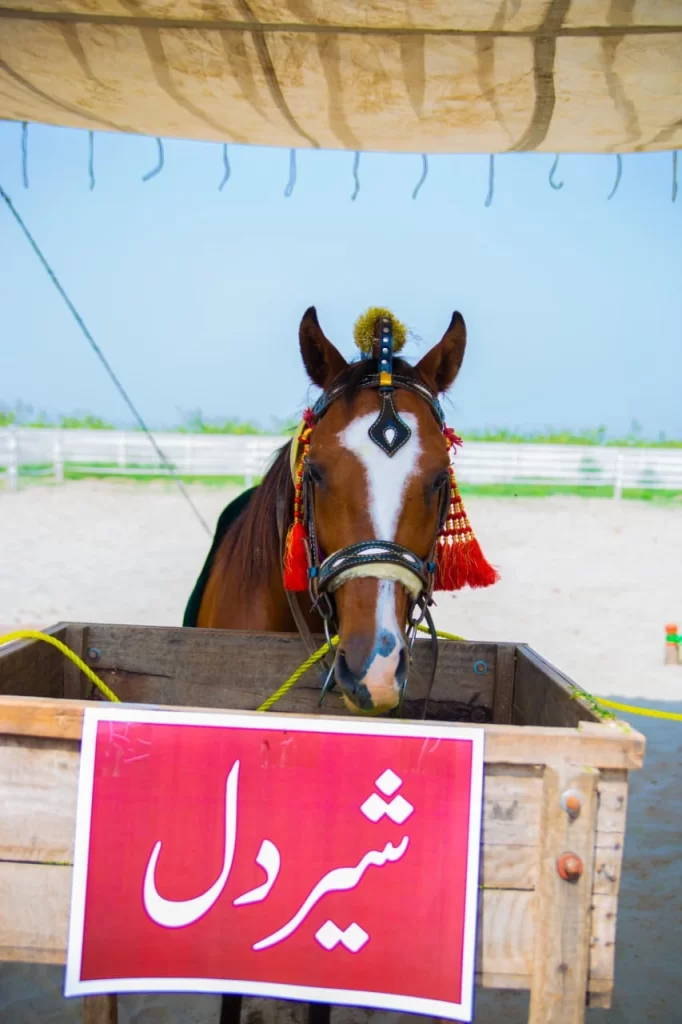
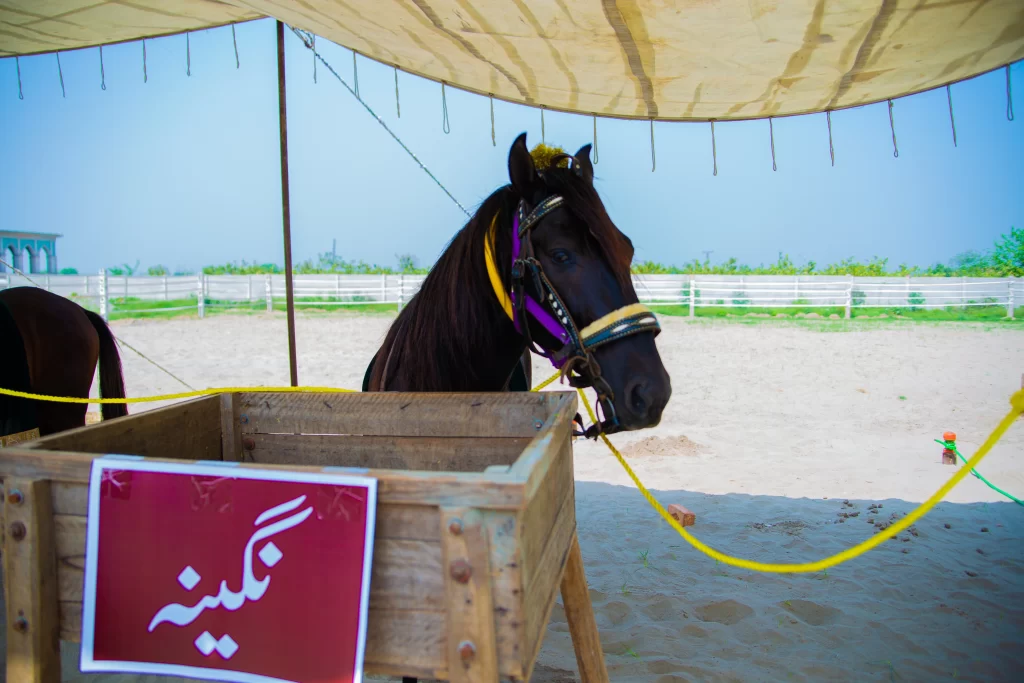
Nageena
Nageena is a beautiful horse. From head to hoof, its entire body exudes a rich, glossy black hue. An elegant and flowing mane further enhances its allure. Horses with luxuriously long tails are revered, and Nageena proudly flaunts this feature. Additionally, its large, expressive eyes are yet another hallmark of a truly beautiful equine specimen.
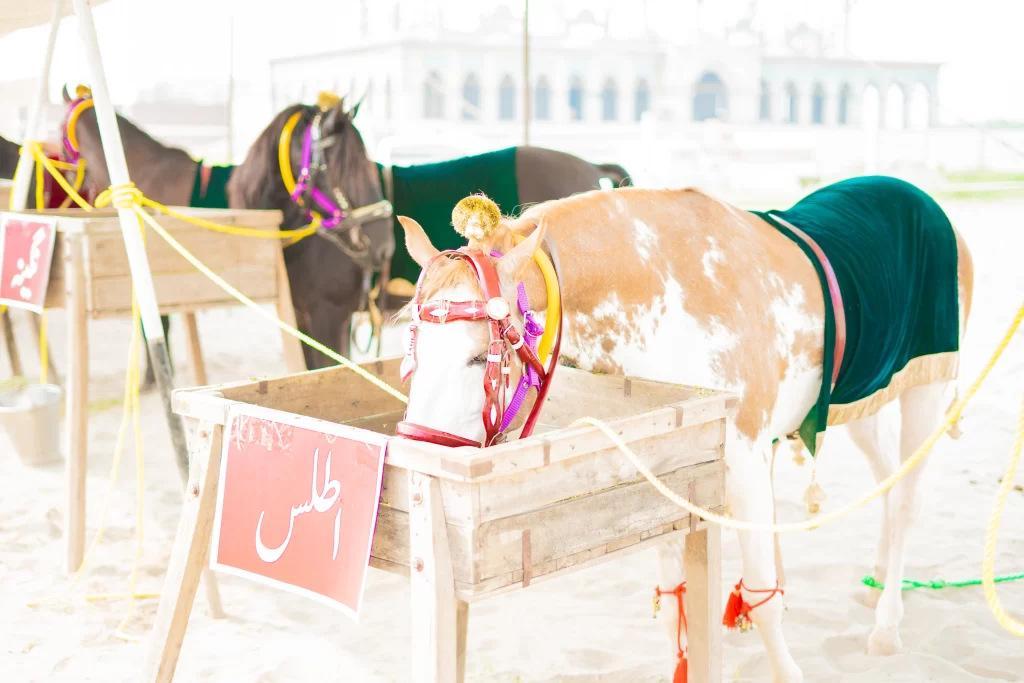
Atlas
In terms of colour, Atlas presents a captivating two-tone palette, skillfully blending white and bay shades. This harmonious combination contributes to its undeniable beauty. Remarkably, Atlas boasts slender hooves and finely structured legs, characteristics that epitomize equine elegance. Its four white legs provide a striking contrast, rendering Atlas exceptionally eye-catching in appearance. Beyond its visual appeal, Atlas is a skilled dancing horse, adept at performing captivating longori and jhumar dances.
